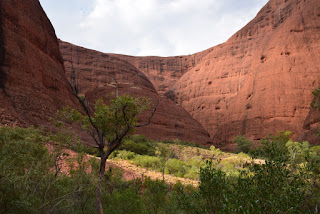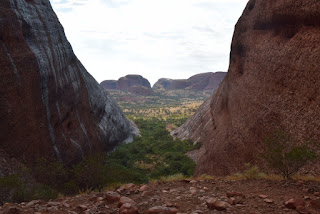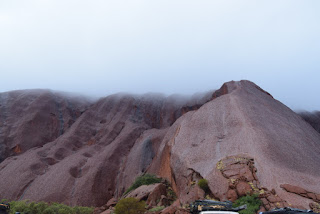After a mere 6 days in
Australia (two of which were in Sydney) we were off again. Cousin Pam and Robin
had flown in and we met up with them in Uluru. Although this is supposed to be
a desert we had 3 days of rain and pretty cold weather. Here is one of the rare
shots of the rock in sunshine.
Tours were largely based on
sunrises and sunsets. After a 4:30 start our first tour was to a waterhole and
caves at Uluru. The rain meant the sunset was not visible but as a result we
did see some rare features such as waterfalls.
It also meant that there were some great contrasting colours.
Our guide took us to a large
cave with a great view one way
and a range of aboriginal
paintings the other. The paintings tell stories and comprise a number of
repeated symbols. A U is a person sitting (as this is the shape they leave in
the sand). If it is accompanied with a
line it is a woman with their digging stick. A man has a boomerang (curved
line). The crown looking design was of hair sometimes interwoven with grass and
used as a pad for carrying items on a woman’s head. Larger versions were used
as belts for the men.
The rain meant that water
holes started to fill quickly and then overflow to their lower counterparts.
Rain is really the main erosion mechanism so changes to the rock surface are
small.
The rocks are sacred to
Aborigines and there are many dream time stories. Two rocks in this photo
represent a bad man who was killed by an irate woman. At the top right you can
see his closed eyes and the spear gashes that preceded his death. At the bottom
left can be seen the head of the woman represented as a snake with the boulders
behind being the snake’s body.
Here are a couple of woman in
a more recognisable form. One of the evenings was a Sounds of Silence dinner
under the stars which was preceded by some champagne and canapes. (Helen’s
dress was bought to show off a necklace made of beads by friend Sue.)
The sunset over the Olgas was
brilliant thanks in large part to the clouds
As is got dark we made our
way from the viewing platform to the open air restaurant. The glow of lights
(and heaters) were warming.
As we ate a large array of
foods including some tasty kangaroo we were treated to the unique and on this
occasion melodic sounds of a didgeridoo.
Our second sunrise tour was
to Kata Tjuta (the Olgas). As we travelled through heavy rain and thunderstorms
the benefit of a 4:30 start was once more a pretty questionable decision! The
focus of this tour was geology rather than dreamtime. Both Uluru and Kata Tjuta
formations were formed by sedimentary rocks uplifting and the surrounding land
slowly eroding away. The Olgas are made of larger cemented rocks and boulders
whereas Uluru comprises more sandy particles. The shear sides of the Olgas is
awesome and as we walked into a gorge we were rather subsumed into the
landscape.
Most of the walk was
relatively straightforward although there was a steep section where some
scrambling was required.
The view from the top of a
large mound between two walls was magnificent albeit difficult to capture the
size and depth in a shot.
As we returned a short shower
changed the orange rock to a glistening wet silver.
A major reason for our
travels was an evening to see the “Field of Lights”. This was cancelled due to
wet weather on each of the evenings and we could not change our booking. We
eventually managed to book a pre-sunrise tour which meant a third day starting
at 4:30. (Not quite the experience Helen was looking for.) Mind you the lights were impressive albeit very difficult to pick up with a camera. Even with a
tripod and timed exposure the lights
would blow in the wind. So here is the best one.
Certainly the size of the
field was enormous with some 5000 lights ("frosted-glass spheres") occupying an area greater than 4 football pitches. Quite a
spectacle. The designer (Bruce Munro) has undertaken similar work elsewhere in the world
but this 12 month show is the largest in terms of area and number of lights.
We travelled round the base
and this is the point where you can climb to the top which I did with some
children from Melba High school (where Helen was Principal) way back in 2006.
As dawn broke we were treated
to a quite unusual view of the rock covered in cloud. More unusual but probably
not as attractive as being in sun.
We then headed to Darwin for
warm weather and evening activities. We started at the Mendil markets for a bite
to eat on the beach while watching the sun set. There were a couple of
interesting shows. The first was some whip cracking – noisy and exhausting.
The relative quite of the
beach helped with the tranquil sunset. Jonathan Livingstone seagull is alive
and well. Flying to the sun and
returning.
As evening set in a second
show started up. Drums, four didgeridoos and lots of energy make for a really
great sound.
Being Darwin where warm
weather is the norm we decided for our second night on a deckchair movie
theatre where we watched Atomic Blonde. The food, drink and atmosphere were great
and the movie was at least action packed so Helen’s normal habit of nodding off
was thwarted.
Our third activity was an
evening sunset cruise with prawns and wine. Fabulous.
Rather than another sunset
shot here is rather a reflective glow of the sun.
Our vessel had several
previous uses before tourism trips including pearl hunting. Her conversion to
tourism has been attractively done.




























No comments:
Post a Comment